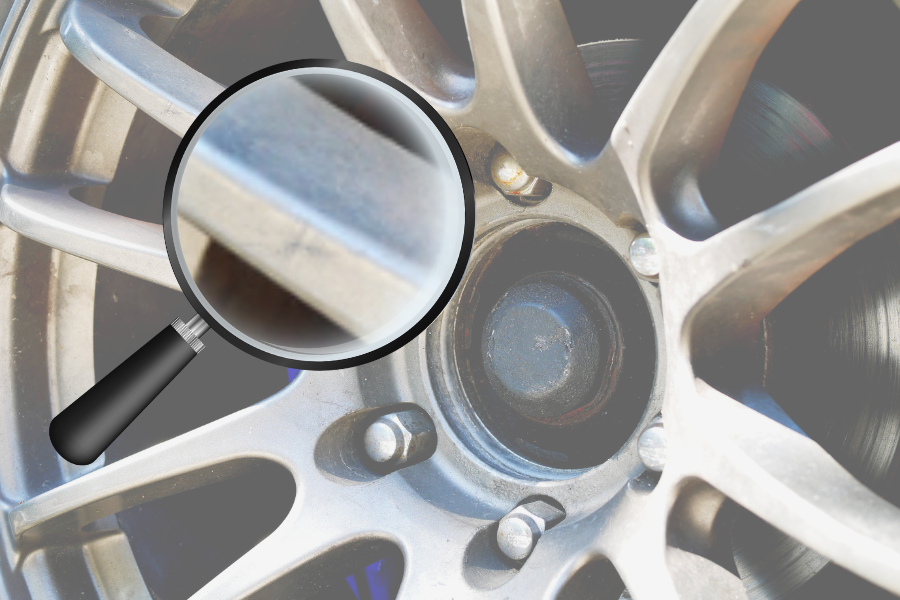
Have you scraped your wheels on a kerb? Don’t worry, you’re not alone. A quick misjudgement, like squeezing into a tight parking spot or clipping a corner just a little too closely, is all it takes.
Frustrating? Absolutely.
Unfixable? Thankfully, not at all. Gutter rash is one of the most common cosmetic knocks your car can take. It might not affect how your car drives, but it definitely dulls the look of your alloys. And once you’ve noticed it, it’s hard to unsee.
Gutter rash is a common form of cosmetic damage that occurs when your alloy wheels scrape against hard surfaces, most often kerbs. It usually happens during parallel parking, tight turns, or misjudging the distance between the wheel and the edge of the road. Even a quick brush against a raised concrete lip can leave visible scuffs.
Alloy wheels are particularly vulnerable to this kind of damage. While they offer a sleek and stylish look, their harder, more brittle surface makes scratches and scrapes more noticeable compared to traditional steel wheels.
It’s possible to repair gutter rash at home, especially if the damage is minor. Light scuffs and shallow scratches can often be improved with a bit of sanding, some careful painting, and a clear coat to finish things off.
However, not all gutter rash is DIY-friendly. Deeper scratches, uneven gouges, or damage near the wheel edge can be tricky to fix cleanly without the right tools or experience. Poorly done repairs may not hold up over time and can actually draw more attention to the damage.
Knowing when to call in the experts can save time, money, and frustration. Professionals will assess the damage, match the finish, and restore your wheel with the right tools and techniques.
If the damage to your alloy wheels is minor, you may be able to fix it yourself with a few tools, some time, and a bit of patience. While DIY results won’t always be perfect, they can significantly improve the appearance of your wheels and help prevent further corrosion.
Here’s how to do it properly:
Thoroughly wash the wheel and the damaged area. Remove all brake dust, dirt, and grease using soapy water or a dedicated wheel cleaner. Dry the area completely before continuing.
Use coarse sandpaper to remove rough edges and smooth out the scuffed area. Be gentle and try to feather the edges into the surrounding undamaged surface.
If the damage has gouged into the metal, apply a small amount of alloy filler to the area. Let it cure according to the instructions, then sand it smooth once it’s hardened.
Use finer grit sandpaper to smooth the entire area and blend it into the rest of the wheel. Once it’s even, clean the surface again with a microfiber cloth and masking tape off the surrounding area to avoid overspray.
Apply a light coat of primer and let it dry. Follow with several light coats of matching wheel paint, allowing time to dry between each layer. Finish with a clear coat to seal the repair and restore shine.
Let the clear coat fully cure (this can take a few hours to a full day, depending on the product). Once dry, gently polish the area for a consistent finish.
A professional alloy wheel repair typically includes a thorough clean and inspection, precise sanding or machining, filler for deeper marks, and a high-quality, colour-matched paint and clear coat. Technicians also check for any structural issues like cracks or buckling that might not be visible at first glance.
In Australia, repairs usually range from $250 to $450 per wheel, depending on the damage and finish. While DIY kits are available, professional services deliver a more consistent result, especially when it comes to colour matching and finish quality.
For many people, the convenience and reassurance of a professional repair, done with the right tools and attention to detail, make it a worthwhile choice. It’s a guaranteed way to make your wheels look like new, without the trial and error.
Once you’ve repaired your wheels, the next step is avoiding damage in the future. While gutter rash is common, a few small changes in how you park and drive can make a big difference.
Most gutter rash happens while parallel parking or manoeuvring into tight spaces. Take your time, use your mirrors, and don’t be afraid to readjust if you’re close to the kerb. Parking a little further out from the gutter, while still within the lines, is often better than risking a scrape.
Wheel protectors or rim protectors are designed to sit between your tyre and the wheel edge, providing a small buffer between the alloy and the kerb. They’re an affordable way to add an extra layer of protection, especially if you park on the street regularly.
Simple changes like approaching driveways and curbs at a wider angle, avoiding tight turns too close to the gutter, and staying alert in multi-storey car parks can all help prevent future scuffs. Being a bit more mindful of your wheel position, especially in unfamiliar or tight spaces, goes a long way.
When it comes to repairing alloy wheels, it’s always worth getting the job done right. At Col’s Body Shop, we offer professional alloy wheel repairs with precision colour matching, high-quality finishes, and quick turnaround times.Whether it’s minor scuffs or more noticeable damage, our experienced team has the tools and expertise to restore your wheels properly. Get in touch today for reliable, professional results you can trust.
Established in 1960, Col’s Body Shop remains one of the longest-established and most trusted smash repair businesses in West Ryde and Greater Sydney.
Proudly servicing West Ryde, Ryde, Gladesville, Putney, Hunters Hill, Meadowbank, Ermington, Marsfield, Macquarie Park, and the surrounding Northern Suburbs and Inner West.
